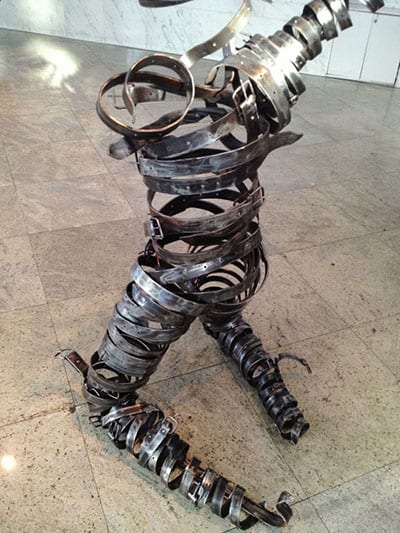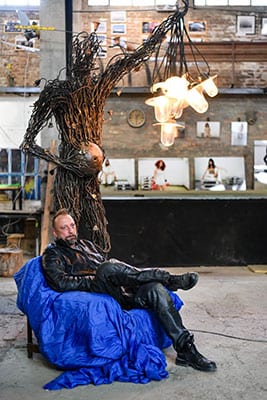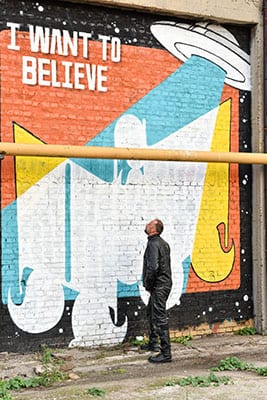“Believe it: Serbia is a great place for many branches of the arts. Services, transport and labour are much more reasonably priced than in other countries. There are tradesmen on every corner, and this would also be an opportunity for them to earn more money than they do on regular jobs. These are also advantages that Serbia should promote, in order for art to slowly become a branch that brings money, but also improves image”
The structure of a wooden house that served as the exhibition space for the ‘Four countries, one language’ project at this year’s International Book Fair in Belgrade, which was used by Germany, Austria, Switzerland and Liechtenstein to present literary works in German, is set to become the gallery space for Ciglana – a Belgrade art quarter located between Karaburma and Višnjićka Banja.
 This very popular place was first ‘discovered’ less than five years ago by Viktor Kiss (b.1973), sculptor and a very special and attractive figure in the city, simply because he has the courage and audacity to live and think in a way that suits him, and because he has converted this abandoned urban area into an artistic zone with workshops and studios, making it a favourite destination for everyone who loves modern art and socialising.
This very popular place was first ‘discovered’ less than five years ago by Viktor Kiss (b.1973), sculptor and a very special and attractive figure in the city, simply because he has the courage and audacity to live and think in a way that suits him, and because he has converted this abandoned urban area into an artistic zone with workshops and studios, making it a favourite destination for everyone who loves modern art and socialising.
Here we speak with Viktor Kiss about his large-dimension sculptures, about Ciglana and the DEV9T Festival that he founded there, about his collaboration with the group The Prodigy and his participation in Nevada’s Burning Man Festival.
You are a sculptor, while you graduated from the Belgrade Faculty of Applied Arts’ Department of Ceramics. These two areas have almost nothing in common. What attracted you to sculpture, in your case; was it the lure of making large sculptures from iron?
– Ceramics was the first material I was introduced to because my father worked at the Technical College in Aranđelovac and brought clay home for me. It is therefore understandable that I first got interested in pottery/ceramics. However, during the time of studying a young man is full of new ideas and wishes; it’s then that he gets interested in technologies that were not previously available to him, and that’s how I was attracted to sculpture and iron. Clay is a material that requires many processes to be turned into a work of art: first, you wait for it to dry, then you process it, then you bake it twice… It can happen that it breaks when you bake it… I’m impatient by nature and so much waiting for the realisation of what I’ve imagined didn’t suit me. With iron you don’t have those problems – however, you shape it, it stays in that position.
Meaning you are self-taught; that you uncovered the secrets of sculpture by yourself?
– I started dealing with welding during my studies, for about ten years I made fences, terraces and gates for the buildings of Belgrade. That’s like a kind of jewellery for buildings. I had a family and had to support it. It was strenuous being at the university in the mornings and the workshop in the afternoon.
I claim that you can slip a silk scarf through my sculptures without it getting snagged. Although they are made of iron, every one of my sculptures is gentle visually and to the touch
Nevertheless, that’s how I learned my craft. I learned to feel how iron behaves, I mastered the statics, meaning everything it’s necessary to know to make an iron sculpture. Then I also started experimenting with the material, combining ceramics and iron, making unique bathroom reliefs instead of tiles. As I told you, that wasn’t easy for me, and I could barely wait to start working on sculptures. I had great support from my wife and family, and I succeeded.
It’s difficult to describe your sculptures: although they are monumental and made of iron, they appear gently and alive. How do you make them?
– I don’t sketch them – I skip that stage. Thanks to my experience in the construction industry, I know what possible problems and statics and everything else I can expect. I don’t see any reason why I would sketch them when I see everything clearly in my mind. I claim that you can slip a silk scarf through my sculptures without it getting snagged. Although they are made of iron, every one of my sculptures is gentle visually and to the touch.
That’s perhaps why they didn’t appear awkward or out of place when you exhibited them in Knez Mihailova Street’s ‘Progres’ Gallery – an environment accustomed to classic works and certainly smaller dimensions. That was the 2013 exhibition “Elements”. How come you exhibited at ‘Progres’?
 – They invited me. I wasn’t interested in exhibitions; I didn’t want to exhibit my works at all, in any gallery, because I didn’t like the behaviour of gallery folk towards the artist. For an artist to set up an exhibition, they have to organise everything themselves, from cleaners to newspaper advertising and marketing. Gallery folk believe that their engagement ends with them having an exhibition space.
– They invited me. I wasn’t interested in exhibitions; I didn’t want to exhibit my works at all, in any gallery, because I didn’t like the behaviour of gallery folk towards the artist. For an artist to set up an exhibition, they have to organise everything themselves, from cleaners to newspaper advertising and marketing. Gallery folk believe that their engagement ends with them having an exhibition space.
I think they are wrong, which is why I didn’t want to exhibit. However, when they called me from ‘Progress’, I didn’t want to refuse. It was a great challenge for me to place my large sculptures in the middle of Knez Mihailova Street. And, voila, it turned out that they fit in well and proved agreeable.
It was also around that time, in 2013, that your engagement began with Ciglana. How did you discover this place?
– I was working in the attic of a locksmith’s workshop, in a low-ceilinged and cramped space. I had to make sculptures in parts, to bring each part down into a larger space, and to then assemble the sculpture. That’s why I started looking for new space; a space with dimensions that correspond to the dimensions of my sculptures. I came upon Ciglana. The “Trudbenik” factory used to produce bricks there, but the source of shale dried up, and the factory didn’t have anything to use to make bricks. I rented one of the workshops and made another space into a bistro. My idea was to use coffee sales to pay the rent for the workshop. And so it began.
Of course, folklore and tradition are things that needs to be noted about us, but on the economic front we would gain a lot more if we revealed to the world that we are a country with capable and skilled people who know how to implement their artistic works.
You soon received company…
– Yes, artists soon started coming to Ciglana, and the abandoned spaces of the factory became artistic units. Artists are individuals, loners, but it is as though Ciglana has brought them together. As such, it has helped them, but also itself, because it is now considered an artistic place, a special place in the city. I don’t understand why there aren’t more such places in Belgrade. It’s not hard to convert an abandoned industrial space into something attractive, which is used for culture and, therefore, for the whole of society. Believe it: Serbia is a great place for many branches of the arts. Services, transport and labour are much more reasonably priced than in other countries.

There are tradesmen on every corner, and this would also be an opportunity for them to earn more money than they do on regular jobs. These are also advantages that Serbia should promote, for art to slowly become a branch that brings wealth but also improves the image.
I don’t understand why Serbia doesn’t use what it has. I don’t understand why it doesn’t present itself as an idyllic place for producing works of art. Imagine how good it would be for artists from all over the world to shine in Serbia! They have everything they need here, cheaper than in their countries. This is not known. Foreigners think all we have in Serbia is folklore! Of course, folklore and tradition are things that need to be noted about us, but on the economic front, we would gain a lot more if we revealed to the world that we are a country with capable and skilled people who know how to implement their artistic works.
For now, foreign residents of Belgrade know about your Ciglana and are frequent guests at gigs in the extremely attractive club.
– And I’m very pleased about that. Ciglana has connected me with people with whom a wonderful friendship binds me.

I will mention Italian Ambassador to Serbia, Mr Giuseppe Manco, and Austrian Ambassador to Serbia, Mr Johannes Eigner. Both of whom, unfortunately, will soon leave to take on new posts. They provided Ciglana with exceptional assistance, bringing artists to the DEV9T Festival. If you wonder why they came here specifically, I have the impression that it’s because I worked with them more than, for example, some of our institutions.
I also established cooperation with German Ambassador Axel Dittmann and Goethe-Institut Belgrade, headed by Mr Baumann. I’m not mentioning their names to elevate the reputation of Ciglana; they behave like ordinary people, like you and I, but they think about how their countries can help our culture and our artists, and that’s a rare treasure. It was their initiative for Ciglana to get the wooden house, the structure housing their stand, after the Book Fair. We will create a gallery in that space, which will significantly improve the life of Ciglana.
This is also an opportunity to mention local organisations that helped this abandoned factory area to become Ciglana.
– Yes, the Municipality of Palilula, on whose territory Ciglana is located. They installed street lighting throughout the area, which was a huge advance for Ciglana.
You could think yourself fortunate in life, because you succeed in accomplishing what you intend – here I mean the fact that you are now making sculptures instead of ceramics, as you wish, and that you have a working space that’s bigger than you imagined, and we don’t even need to mention the encounter with The Prodigy. Well, I know everyone asks you about that, but please tell CorD readers how you met the members of that famous group.
– By accident. Prodigy was in Novi Sad, at Exit’s Warrior Dance Festival, for which I created sculptures. I decided to enrich their backstage with sculptures too. They liked how I’d done that, so they sought me out. I remember that I was working on a sculpture for some sponsor when they appeared and said, “come for a talk when you have the time.” Probably during our first conversation I acted more like a star than them! It was an unexpected experience: you realise it’s possible to remain true to what you are despite being mega popular. They bought a sculpture from me, and I took it to London. There they took me to a studio where, apart from them, many stars record, including Madonna, and introduced me to British artists… It was unforgettable.
And “Burning Man” in Nevada? It’s rare for our artists to appear at that festival. You were there two years ago. What makes it special?
– It’s held in the Nevada Desert, and it really is special.

Many artists bring their sculptures and stick them in the sand. Of course, I did so myself. I made a giant iron man throwing his head into the sand. Burning Man is the biggest show of festival art. In my opinion, art shouldn’t be separated, but… Works of high art are made during the course of this festival. It’s a shame that they are set on fire at the end of the festival, but – that’s the rule. They say: art is not important; people are important. That’s why they burn everything that’s made there. My sculpture was called Changes, because I experienced some changes there in Nevada.
In comparison, what does the DEV9T Festival you founded at Ciglana look like?
– DEV9T is a festival of all arts, not just fine arts. This summer will be held for the fourth time. Last year we had 35,000 visitors in seven days, and I think that number says enough about DEV9T. Entrance is not free, nor do we organise transportation.
But still people came, and in numbers that aren’t small for alternative art. This autumn we’ve launched another festival, ‘Spajalica’ (Connector). A special characteristic is that the programmes overlap: the beginning of one programme overlaps with the end of the previous, in order to connect their audiences and artists.
Why are you doing all this? Wouldn’t it be easier for you to behave like all other artists?
– From birth, you are subordinate to society and its system. The system dictates how you behave in society, how to please it. Nobody offers you the chance to think about yourself. That’s why within this system you have to find a system to think about yourself because you are the tool that contributes to society. Otherwise, you become a screw that has no individuality. This is the time when people are made into screws, and there are lots of clever people and it’s not fair that people become screws. It is necessary to liberate the need to create.